Highway to Ruin: The crash of Southern Airways flight 242
Note: this accident was previously featured in episode 19 of the plane crash series on January 13th, 2018, prior to the series’ arrival on Medium. This article is written without reference to and supersedes the original.

On the 4th of April 1977, a brief flight from Huntsville, Alabama to Atlanta, Georgia took a terrifying turn when the DC-9 encountered a powerful thunderstorm at 17,000 feet. As torrential rain and hail slammed the plane, the pilots quickly found themselves in a nightmare scenario, as both engines failed in the heart of the storm, sending the powerless plane plummeting from the sky. Desperately searching for a place to land their crippled airliner, the pilots set their sights on what seemed to be their last hope for salvation: State Highway 92 in New Hope, Georgia. As the passengers braced for impact, the pilots set the DC-9 down on the narrow, two lane road — only for all hell to break loose as the wings clipped trees and power poles, sending the plane careening into a gas station, a forest, and a rural neighborhood. By the time the flaming wreckage came to a halt, 72 people were dead: 63 of the 85 aboard the plane, and nine on the ground.
The crash would ultimately provide valuable lessons in several areas of aviation safety, ranging from weather reporting to emergency decision-making. Investigators would discover a series of organizational failures that left the pilots without adequate weather information; gaps in pilot training; and a previously unrecognized danger to all aircraft engines. But perhaps most heartbreakingly of all, they would find that the crash could have been so easily avoided: in fact, Southern Airways flight 242 could have made it to an airport, if only the crew had known it existed.

The Southern United States is routinely strafed by some of the world’s most severe convective weather systems, from slow-moving hurricanes to destructive hail to violent tornadoes. For those who fly there, life is a constant battle to stay on top of the latest weather developments, as thunderstorms appear and disappear in a matter of minutes, bringing powerful winds and heavy rain to localized areas with little warning. But it is a battle which can be won with the right information — if airlines are willing to do what it takes to acquire it.
In 1977, the largest local airline in the region was Southern Airways, a carrier specializing in short flights between cities across the South. Many of these routes would not be viable today due to improved roads, but in the 1970s it was still common to fly these brief “puddle-jumper” routes using midsized jet aircraft. To this end, Southern Airways operated a large fleet of Douglas DC-9 twin rear-engine jets designed for short, regional flights with up to 100 passengers.

On the morning of April 4th, 1977, Captain Bill McKenzie and his colleague First Officer Lyman Keele reported for duty in Atlanta to fly a series of Southern Airways flights back and forth between Georgia and neighboring Alabama. They had just come off the minimum rest period allowed by law, and there wasn’t time to eat a meal, but that was life at a regional airline.
Several hours later, now nearing the end of their shift, McKenzie and Keele departed the town of Muscle Shoals, Alabama, before landing in nearby Huntsville 23 minutes later. The lunch hour had come and gone, but there was no time to eat: their turnaround time in Huntsville would be just ten minutes. And so, after a brief passenger swap, Southern Airways flight 242 taxied away from the ramp with 81 passengers and four crew on board, bound for Atlanta, Georgia.
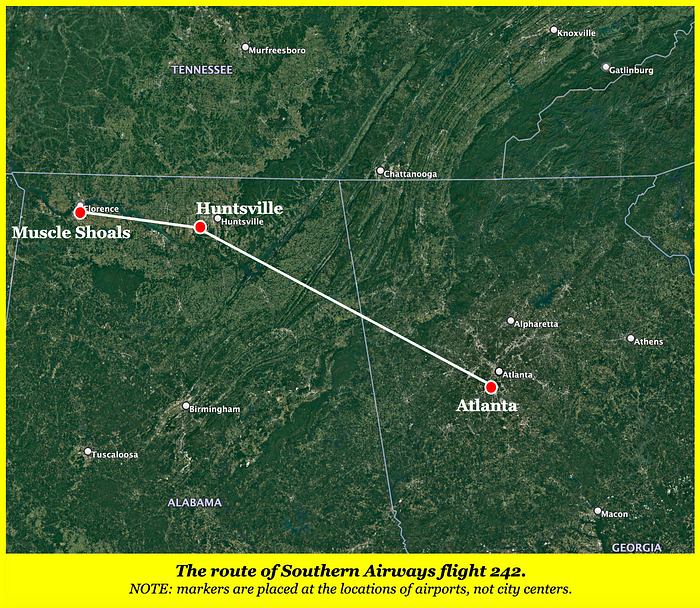
The weather over the Southern United States that afternoon was quickly deteriorating, as it often does during the turbulent months of spring. Forecasts issued early that morning had warned of scattered thunderstorms of moderate intensity, but by the time flight 242 departed Huntsville at 15:54, these forecasts were already outdated. In fact, a band of severe thunderstorms was materializing with extraordinary rapidity across a zone stretching through eastern Alabama and into northwestern Georgia, triggering a flurry of frantic warnings by various agencies. Huge cumulonimbus clouds surged to heights in excess of 40,000 feet; tornado watches were issued, followed by tornado warnings as funnel clouds began to touch down across the region; and local communities experienced torrential rainfall and dangerous hail. As meteorologists monitored the developing situation, the National Weather Service (NWS) began issuing SIGMET (Significant Meteorological Information) warnings in an effort to alert airlines to the danger.
But the crew of flight 242 had none of this information. They only had the general forecast, now hours out of date, and a series of weather observations at airports along their route, none of which provided any indication of severe thunderstorms. And since they had just flown this route in the opposite direction two hours earlier and encountered clear conditions, the pilots had no particular reason to expect trouble. Little did they know how wrong they would turn out to be.
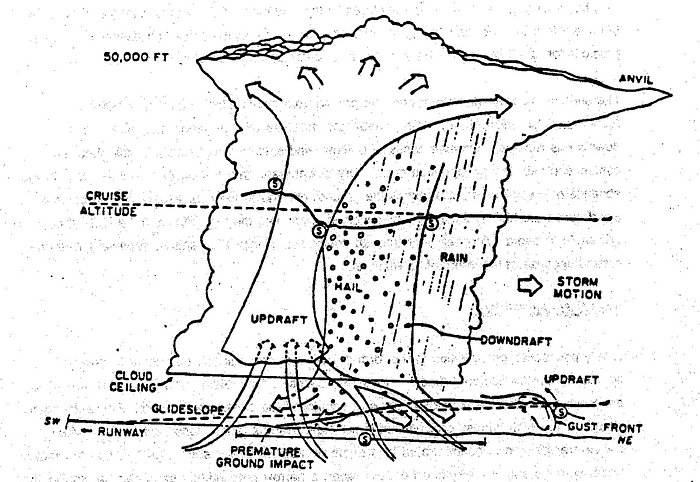
By the time flight 242 departed, rain was falling over Huntsville Jetport, and there was no way to visually identify any storms that might lie between Huntsville and Atlanta. As such, the pilots planned to rely primarily on their on-board weather radar, a Bendix RDR-1E with a black and white cockpit display. Within two minutes after takeoff, it started picking up a solid line of thunderstorms a few miles ahead, stretching in a long line across northwestern Georgia.
“Well, the radar is full of it, take your pick,” said Captain McKenzie, who was monitoring the instruments while First Officer Keele flew the plane.
Two seconds later, the Huntsville controller called the flight and said, “Southern two forty two, I’m painting a line of weather which appears to be moderate to, uh, possibly heavy precipitation starting about five miles ahead.”
“Okay, uh, we’re in the rain right now,” McKenzie replied. “It doesn’t look much heavier than what we’re in right now, does it?”
“It’s not a solid mass, uh, it appears to be a little bit heavier than what you’re in right now,” said the controller.
“Okay, thank you.”
Pointing at the weather radar, First Officer Keele said, “I can’t read that, it just looks like rain, Bill. What do you think? There’s a hole — ”
“There’s a hole right there,” McKenzie interrupted. “That’s all I see.”
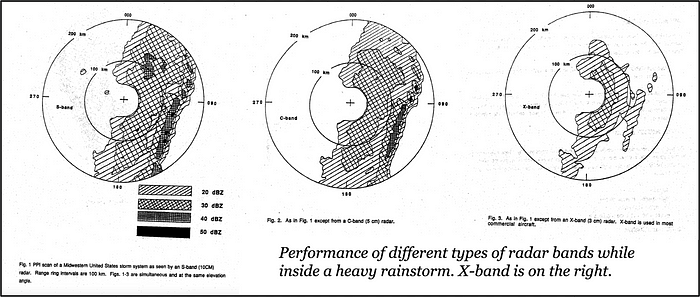
On their primitive two-color display, areas of precipitation appeared as white static on a black background. The only way to determine the intensity of the precipitation was to switch the radar to contour mode, in which areas of particularly heavy rainfall or hail would appear as dark areas inside the white static. Because the background and the contour holes were the same color, it was not a user-friendly system, but the pilots were used to reading it and were familiar with its nuances — most of them, at least.
Notably, the radar operated in the X-band region: a high-frequency, short-wavelength spectrum which is particularly vulnerable to attenuation by precipitation. Studies have shown that heavy rain near the emitter and layers of water on the airplane’s nose cone can interfere with the signal to such an extent that the range and effectiveness of the radar will be significantly reduced. In fact, so much of the power emitted by the radar may be absorbed by nearby precipitation that no signal will return at all from more distant targets, creating blind spots on the display (as shown above).
As flight 242 flew through clouds and rain after takeoff from Huntsville, the rain is thought to have attenuated the signal, blurring the boundaries between the radar returns and reducing their intensity, making it difficult to tell the difference between a dark contour and an area free of precipitation. It was because of this lack of clarity that both pilots made what would turn out to be a fatal mistake: what they interpreted to be a gap between the thunderclouds was actually a contour hole indicating the heaviest part of the storm.
As flight 242 plunged deeper into the bad weather, the controller called them and said, “Southern two forty two, you’re in what appears to be about the heaviest part of it now. What are your flight conditions?”
“Uh, we’re getting a little light turbulence now, and I’d say moderate rain,” said Captain McKenzie.
“Okay, and uh, what I’m painting, it won’t get any worse than that,” said the Huntsville controller, before handing the flight over to Memphis Center.
“As long as it doesn’t get any heavier, we’ll be alright,” Captain McKenzie commented.
“Yeah, this is good,” First Officer Keele agreed.
At that moment, Memphis Center broadcast a new SIGMET warning applicable to parts of Louisiana, Mississippi, and Alabama.
“Oh shit,” McKenzie exclaimed. But they were already crossing into Georgia, and Georgia wasn’t included, so they seemed to be in the clear.
Moments later, the plane entered heavy turbulence. As the rain picked up and the plane began to sway, McKenzie exclaimed, “Here we go, hold ’em cowboy!”
“I can handle this all the way over,” said Keele.
“I think we better slow it up here in this crap,” said McKenzie.
“Got ya covered,” said Keele, rolling back engine power to slow the plane and, hopefully, lessen the impact of the turbulence.
Flight 242 reached its cruising altitude of 17,000 feet. The storms on their weather radar continued to intensify.
“Looks heavy, nothing’s going through that,” said McKenzie. “See that?”
“That’s a hole isn’t it?” Keele asked.
“It’s not showing a hole, is it?”
The sound of rain began to intensify. “Damn!” Keele exclaimed. “Do you want to go around that right now?”
“Hand fly at about 285 knots,” McKenzie ordered.
Suddenly, hailstones began to slam into the plane, bouncing off the fuselage in a cacophony of bangs and crashes.
“Which way do we go, cross here or go out — I don’t know how we get through here, Bill!” said First Officer Keele. The gap they thought they saw on their radar minutes earlier, the gap that never was, had seemingly closed in around them. They were in the thick of it now, and there would be no escape.
In the cockpit, the pilots kept trying to find a way through the storm. “I know, you’re just gonna have to go out — ” said McKenzie.
“Yeah, right across that band.”
“All clear left approximately right now, I think we can cut across there now.”
“Alright, here we go!”
The hail increased in intensity, battering the plane with chunks of ice the size of tennis balls.
“Southern two forty two, descend and maintain one four thousand,” the controller instructed. The flight was so short that it was already time to leave their cruising altitude of 17,000 feet. The pilots rolled back engine power even more, all the way to idle, and the plane began to descend.
Back in the cabin, flight attendant Sandy Ward, sensing something was amiss, picked up the PA and said, “Keep your seatbelts on and securely fastened, there’s nothing to be alarmed about, relax, we should be out of it shortly.”
But there was in fact plenty to be alarmed about. Unknown to anyone on board, the DC-9’s engines were on the verge of failure.

When flying in rain and hail, a jet engine will naturally ingest water and ice along with air. Evaporating this water and ice requires excess energy, reducing the efficiency of the engines. And if too much water enters a jet engine, so much energy will be expended to evaporate it that the temperature of the combustion chamber will drop too low for the fuel-air mixture to ignite, causing the engine to flame out.
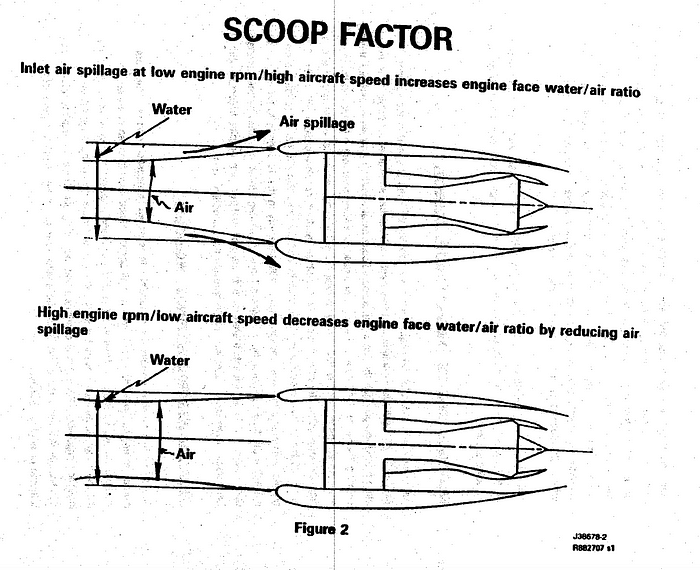
This danger is especially pronounced at low engine power settings due to something called the “scoop factor.” As a plane travels forward, its engines “scoop up” a column of air with dimensions roughly equal to the area of its intake. But at low power settings, the engine cannot (and does not need to) process this much air, and so a pressure wave will build up in front of the inlet, forcing some air in the aforementioned column around the outside of the engine instead. But water droplets and hailstones, due to their greater momentum, will not be pushed around the outside of the engine, and will continue through the inlet regardless. As such, an engine at low power will take in less air, but the same amount of water, as an engine at high power. This “scoop factor” means that the ratio of water to air entering an engine operating at low power can be up to three times greater than the nominal water-to-air ratio outside the plane.
As flight 242 descended through the torrential storm with its engines at flight idle, the concentration of water inside the engines became so great that their power output could not keep up with demand. With every bit of excess energy going into melting the ice and evaporating the water, the engines’ rotation speeds dropped below the threshold required to keep the electrical generators online, and the plane abruptly lost all electrical power. The cabin lights went out, the pilots’ instrument panels went dark, and the flight recorders ceased recording.
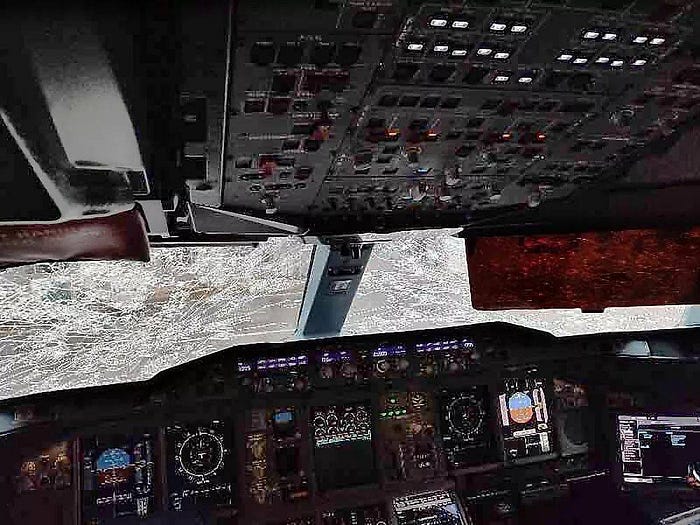
Thirty-six seconds passed, suspended in darkness, before First Officer Keele advanced the throttles enough to bring the generators back online and restore electrical power. The lights and instruments flicked back on, and the cockpit voice recorder captured Keele saying, “Got it back, got it back, Bill, got it back, got it back!”
During the power interruption, the crew missed four radio calls from air traffic control. Finally, the fifth one went through. “Southern two forty two, Atlanta?” the increasingly concerned controller called out.
“Uh, two forty two, stand by,” McKenzie hastily replied.
Hail continued to smash into the windshield, sending a spiderweb of cracks snaking across its outer layer.
In the background, flight attendant Sandy Ward could be heard making an emergency announcement. “Check to see that all carry-on baggage is stowed completely underneath the seat in front of you… in the unlikely event that there is a need for an emergency landing, we do ask that you please grab your ankles, I will scream from the rear of the aircraft, there is nothing to be alarmed, but we have lost temporary APU power at times, so in the event there is an unlikely need for an emergency you do hear us holler, please grab your ankles… thank you for your cooperation, and just relax, these are precautionary measures only…”
At the same time, in an attempt to ensure proper separation from nearby traffic, the controller ordered flight 242 to level off at 15,000 feet. “Maintain one five thousand if you understand me,” he said.
“We’re trying to get it up there,” said Captain McKenzie, noting that they had fallen below this altitude amid the chaos. “Okay, uh two forty two, we just got our windshield busted, and we’ll try to get it back up to fifteen, we’re fourteen…”

As the pilots struggled with these multiple failures, the engines began to surge. A surge occurs when airflow through a jet engine momentarily reverses direction, with explosive results. The circumstances for a surge occur when the delicate balance of temperatures and pressures within the various compressor stages, which compress and accelerate the air to generate thrust, is disrupted. If the differences in temperature and pressure between the low pressure compressor and the high pressure compressor become too great, air will abruptly shoot forward from the high pressure zone into the low pressure zone, against the normal direction of flow.
On flight 242 a reduction in temperature occurred within the low pressure compressor stages due to ingestion of water and ice into this part of each engine. A lower temperature naturally leads to a lower pressure. As a result, the pressure ratio between the low and high pressure compressors increased, moving close to the point at which a surge would occur. When the pilots accelerated the engines to bring the electrical power back online, the pressure ratio became even greater, leading to surges as the high pressure further back in the engine forced air forward against the normal airflow. The resulting spike in pressure inside the low pressure compressor section bent the compressor blades forward, severely damaging them. At this point, not all was yet lost — the engines could still function, albeit poorly — but an unfortunate coincidence was about to deal them both a killing blow.
When an engine begins to surge, proper procedures hold that a pilot must immediately reduce engine power, allowing the surge to clear. If performed promptly, this action will prevent fatal damage to engine components. In contrast, accelerating while in a surge will cause the surge to continue until it destroys the engine. Tragically, it was right as its engines began surging that air traffic control asked flight 242 to climb back to its assigned altitude of 15,000 feet, prompting First Officer Keele to increase engine power at the worst possible time.
Before he could even notice that the engines were surging, the damage had been done. The increased fuel flow through the already damaged engines resulted in immediate overheating; aluminum components quickly melted, spraying slag throughout the compressor sections. Within a minute, both engines would be damaged beyond repair.
“Left engine won’t spool!” Keele exclaimed as the damage began to take its toll on its power output.
“Our left engine just cut out!” McKenzie relayed to air traffic control.
Electrical systems started to drop off the line again, including the plane’s transponder, which broadcasts data about its identity and location. “Southern two forty two, roger, and uh I lost your transponder, squawk five six two three,” said the controller.
“I am squawking five six two three, tell him I’m level at fourteen!” Keele said.
“Five six two three, we’re squawking,” said McKenzie. But the controller couldn’t see this identification signal on radar because the plane’s transponder had failed.
“Say you lost an engine and uh, busted a windshield?” the controller asked with increasing concern.
“Yes sir!” said McKenzie. Turning to Keele, he asked, “Autopilot’s off?”
“I’ve got it, I’ll hand fly it!” said Keele.
Captain McKenzie picked up the intercom to inform the flight attendants about the emergency, but he managed only to say, “Sandy — ” before Keele interrupted him with even more dire news: “My god,” he said, “the other engine’s going too, damn!”
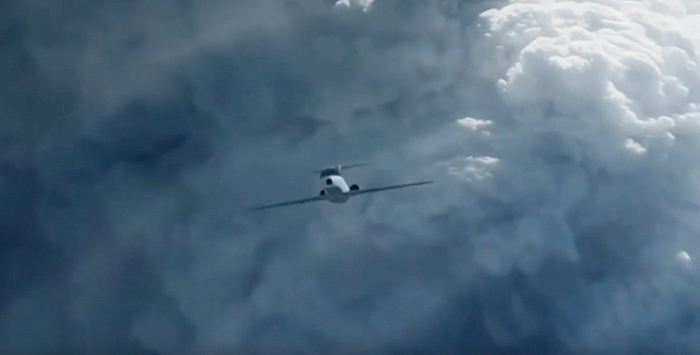
Now the pilots were truly in uncharted territory. In 1977, there was no procedure for dealing with a double engine failure — they were on their own.
“Got the other engine going too!” McKenzie reported to Atlanta Center.
“Southern two forty two, say again!?” asked the astonished controller.
“Stand by — we lost both engines!” said McKenzie.
“Alright Bill, get us a vector to a clear area,” Keele asked.
“Get us a vector to a clear area, Atlanta!” McKenzie said to the controller.
“Uh, continue present southeastern bound heading, TWA’s off to your left about fourteen miles at fourteen thousand and says he’s in the clear,” the controller replied.
“Okay,” said McKenzie. “Want us to turn left?”
“Southern two forty two, contact approach control one two six point nine and they’ll try to get you straight into Dobbins,” said the controller.
Dobbins Air Force Base had a long runway and was closer than Atlanta, a good option for an emergency landing. And by coincidence, it was also where First Officer Lyman Keele had been based when he was in the military.
“Give me — I’m familiar with Dobbins,” he said. “Tell them to give me a vector to Dobbins if they’re clear.”
In response, the controller handed them over to approach control in order to receive further instructions. Meanwhile, the pilots attempted to speed through the engine restart checklist.
“Ignition override, it’s gotta work, by god — damn,” Keele cursed.
Six seconds later, with its engines now fully dead, the plane lost all electrical power for a second time, and the black boxes again ceased recording.
For the next 124 seconds, the plane glided downward without power, the decisions of its pilots shrouded in mystery. For some reason, instead of continuing straight toward Dobbins, the pilots now made a 180-degree right turn back the way they came — a move which significantly reduced their chances of reaching any airport. Although investigators would never be certain of their reasoning, it is thought that the plane emerged momentarily into clear conditions, and the turn was made in an attempt to follow the clear path out of the storm. It is also likely that the pilots believed their engines could be restarted, and were not yet thinking about their optimal glide distance. In any case, it was a decision which would have unforeseen consequences.
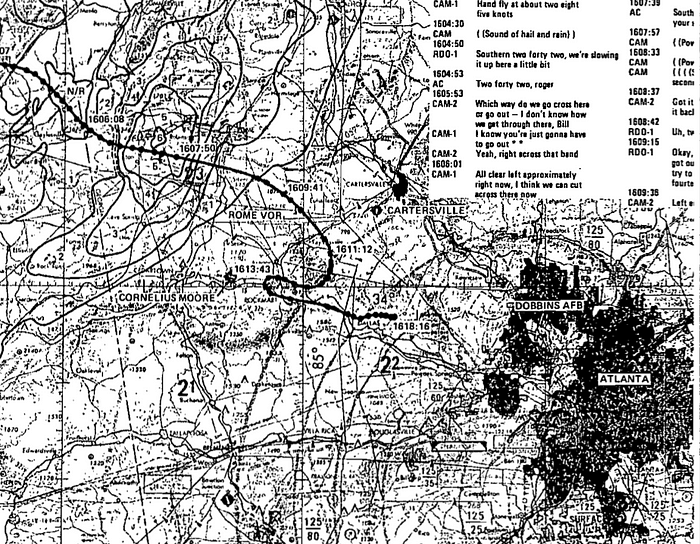
After two minutes without power, the pilots started the auxiliary power unit, the plane’s backup generator, and the electrical system surged back to life.
“There we go,” Captain McKenzie announced.
“Get us a vector to Dobbins,” Keele ordered.
Contacting Atlanta approach, McKenzie said, “Uh, we’ve lost both engines — how about giving us a vector to the nearest place? We’re at seven thousand feet.”
“Southern two forty two, roger,” said the controller. “Turn right heading one zero zero, will be vectors to Dobbins for a straight-in approach runway one one… your position is fifteen, correction, twenty miles west of Dobbins at this time.”
Without engine power, the DC-9 had become little more than a very expensive glider. With Dobbins still 20 miles away and the plane already down to 7,000 feet, there was no way to reach the airport unless they could restart an engine. Unfortunately, this would be impossible.
As flight 242 turned back around toward Dobbins, First Officer Keele said, “Declare an emergency, Bill!”
As McKenzie clarified their emergency status with air traffic control, the plane continued to drop inexorably toward the ground. “Get those engines [started]!” Keele exclaimed.
Moments later, Keele went on the radio himself and said, “Alright, listen, we’ve lost both engines, and I can’t tell you the implications of this, uh, we’ve only got two engines… and how far is Dobbins now?”
“Southern two forty two, nineteen miles,” said the controller.
Flight 242 was already descending out of 5,800 feet and falling fast. The situation looked increasingly hopeless.
“Southern two forty two, do you have one engine running now?” the controller asked.
“No,” said Keele.
“Negative, no engines,” McKenzie reported. To his first officer, he said, “Just don’t stall this thing out.”
“No I won’t!” Keele declared.
The pilots hurriedly configured the plane, searched for the Dobbins approach charts, and asked for the Dobbins weather. But when the controller reported that they still had 17 miles to go, while they were descending out of 4,600 feet, they had to finally face reality.
“I don’t know whether we can make that or not,” McKenzie grimly reported.
“Ah, ask him if there is anything between here and Dobbins?” Keele asked.
Meanwhile, lead flight attendant Anne Lemoine picked up the intercom to talk to Sandy Ward in the back. A special cockpit voice recorder channel captured their conversation.
“Sandy?”
“Yeah?”
“They would not talk to me — when I looked in, the whole front windshield is cracked.”
“Okay, so what do we do?”
“Ah, have they said anything?”
“He screamed at me when I opened the door, ‘just sit down,’ so I didn’t ask him a thing. I don’t know the results or anything, I’m sure we decompressed.”
“Ah yes, we’ve lost an engine.”
“I thought so.”
Simultaneously, the pilots searched for any possible landing site.
“Southern two forty two, no sir, the closest airport is Dobbins,” said the controller.
“I doubt we’re going to make it,” said McKenzie, “but we’re trying everything to get something started.”
“Roger, well there is Cartersville,” the controller suddenly pointed out. “You’re approximately ten miles south of Cartersville, fifteen miles west of Dobbins.”
“We’ll take a vector to that, yes, we’ll have to go there,” said Keele.
“Can you give us a vector to Cartersville?” McKenzie asked.
“Three six zero, roger,” said the controller.
But it was clear that with their low altitude, they were running out of time. Even Cartersville was now too far away. “Like we are, I’m picking out a clear field,” McKenzie decided.
First Officer Keele had another idea. “Bill, you’ve got to find me a highway!”
“Let’s get the next clear, open field!” McKenzie argued. But they were over a heavily forested area, and their options were limited. Within moments, he gave in. “See a highway over there, no cars,” he said, pointing almost dead ahead.
“Right there, is that straight?” Keele asked.
“No,” said McKenzie.
“We’ll have to take it,” Keele concluded. He was right — there was no turning back now.
The road in question was a spur of State Highway 92, a rural two-lane highway running through the tiny town of New Hope, Georgia. In New Hope, some residents had taken shelter underground due to a tornado watch; others were still going about their business, patronizing the town’s combined gas station and convenience store. None could have imagined that their community was seconds away from becoming a disaster zone, as the crippled DC-9, in near-complete silence, bore down upon them from out of a bright spring sky.
On board the plane, First Officer Keele lined up with the highway and extended the landing gear. To air traffic control, McKenzie uttered one final transmission: “We’re putting it on the highway, we’re down to nothing.”
“Oh Christ, Bill, I hope we can do it,” said Keele. “I’ve got it, I’ve got it. I’m going to land right over that guy.”
“There’s a car ahead,” McKenzie warned.
“I got it Bill, I’ve got it now, I got it.”
“Okay. Don’t stall it!”
“We’re going to do it right here.”
In the cabin, a flight attendant shouted for the passengers to brace for impact. “Bend down and grab your ankles!”
“I’ve got it!” Keele exclaimed.
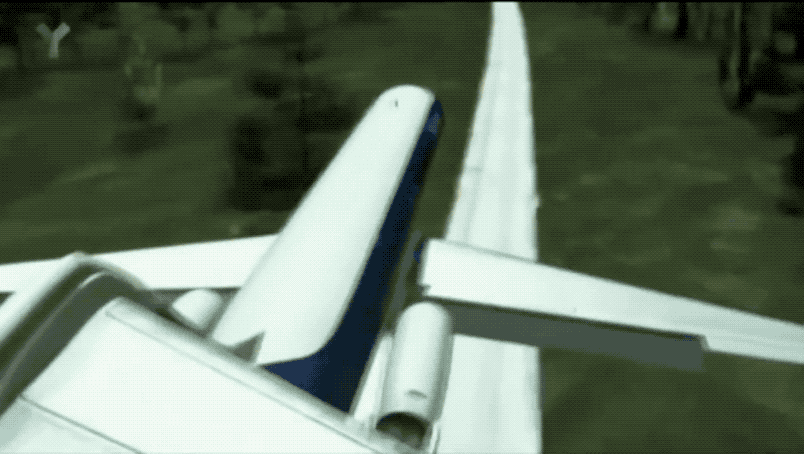
At that moment, the left wing struck several trees alongside the road, but the plane held straight, mowing down additional trees as it came in low over the narrow highway. Dipping lower, both wings began to tear down utility poles, sending power lines flying in every direction. The main gear touched the ground and the pilots lunged for the brakes, but it was too late — they were out of control. “Shit!” someone exclaimed, the final word on the cockpit recorder, and then the left wing slammed into an embankment, sending the plane slewing violently off the side of the road. The DC-9 skidded directly into the gas station, triggering a massive explosion as it ripped the pumps out of the ground and flattened cars in the parking lot. Breaking up as they went, and surrounded by flames, the remains of the plane continued across several fields and into a forest, trees ripping into the fuselage with terrible force, one after another. The wings and tail broke away and the fuselage split into five pieces, tumbling over and over, throwing passengers out into a whirlwind of fire and metal. And then, with one last crunch and the tinkle of glass, it was over.
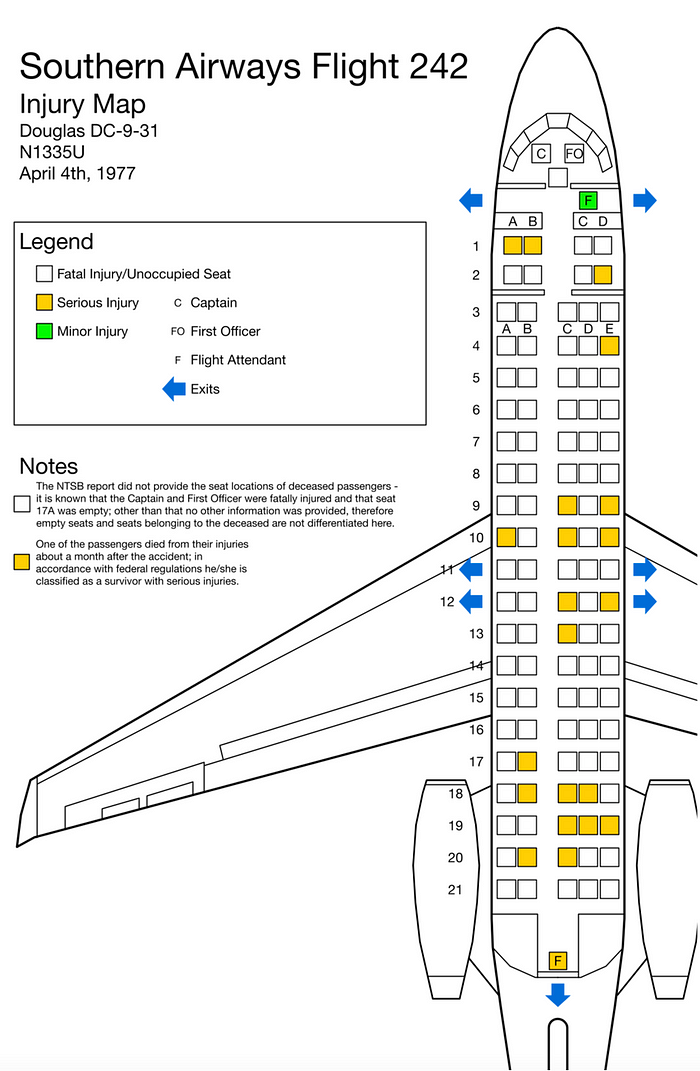
◊◊◊
Despite the violent breakup, around half the passengers and crew survived the initial crash, but their fight was far from over. In the center and tail sections, flames from the ruptured fuel tanks penetrated the cabin even before the plane came to a halt, sending a fireball tearing down the aisle atop the passengers’ heads. Now, that same fire threatened to overcome anyone who could not quickly escape the mangled wreckage. In the front of the plane, lead flight attendant Anne Lemoine found herself hanging upside down from her seat in what used to be galley, having miraculously avoided serious injury. She unbuckled herself, dropped to the ground, and emerged into a scene of complete pandemonium. Nearby, four passengers from the front of the plane had survived despite being ejected during the breakup sequence; further back, another two escaped from just in front of the wings, suffering severe burns in the process. Aft of the wings, eight people still inside the cabin managed to get out before fire overtook them, while in the tail section, another five escaped with their lives, including flight attendant Sandy Ward and four passengers who were thrown from the plane still strapped into their seats. But most were not so lucky: some 40 passengers and crew, including both pilots, died on impact, and another 20 perished due to smoke and fire shortly afterward.

As the badly injured passengers staggered from the wreckage of the DC-9, they made their way into the nearest house: a humble rural home belonging to New Hope resident Sadie Hurst, whose front yard now played host to most of what remained of the plane. Although New Hope’s volunteer fire department had witnessed the crash and was on the scene almost immediately, her living room became a triage center as the first responders struggled to help the wounded while waiting for professional emergency services to arrive from neighboring towns. Except for flight attendant Anne Lemoine, everyone had suffered serious injuries, and despite the heroic efforts of the first responders and doctors at local hospitals, two more passengers would succumb to their injuries in the days and weeks after the crash, leaving just 22 survivors out of 85 passengers and crew.
On the ground, the toll was also heavy. Nine residents of New Hope, including seven from a single extended family, were killed instantly when the plane struck their cars outside the gas station. A trail of mangled vehicles, some rendered almost unrecognizable, testified to their horrific end. Their deaths brought the total number of victims to 72 — the worst air disaster in Georgia history, a title the crash still holds 45 years later. However, investigators would later note that the toll could have been even worse were it not for the prudent actions of the flight attendants, who, despite not receiving any directions from the pilots, prepared the passengers for a worst case scenario from the moment the engines failed. Their heroism and steadfastness under stress belied their young age — Lemoine was 26 years old, and Ward was just 22.

Later that day, National Transportation Safety Board investigators converged on the scene, where they faced an accident unprecedented in aviation history. Not once since the introduction of jet aircraft in 1952 had a passenger jet suffered a total loss of power in all its engines. The reliability of jet engines had proved so high in service that the DC-9’s emergency handbooks didn’t even include a procedure for a dual engine failure. But one look at the engines showed conclusively that they were not running when the plane struck the ground. So how could such a thing have happened?

The investigation would ultimately center on the weather conditions which flight 242 encountered over Georgia that afternoon. By collating weather observations made in vicinity of flight 242’s flight path, the NTSB was able to determine that the ill-fated DC-9 flew through a rainstorm that could only be described as torrential. At a nearby airport in the town of Rome, a rain gauge recorded 1.2 inches (3 cm) of rainfall in the space of just ten minutes, right as flight 242 was passing overhead. Furthermore, witness statements indicated that the plane was struck by hailstones which were variously judged to be anywhere from the size of ping-pong balls to the size of tennis balls — either way, enormous. The hailstones were strong enough to break the windshield and dent the inlet rings on both engines. Could they have damaged the engines’ internal components too?
Surprisingly, the answer was no — neither the fan blades nor the compressor blades showed any evidence of hail damage. Instead, the engines were destroyed from within by unchecked surging. Tests by the manufacturer subsequently showed that if the concentration of water and ice in the air was sufficiently high, it could lead to engine flameout, or to surges if power was suddenly increased. This result came as a surprise to industry experts, who up until then had never had reason to believe that heavy rain posed a danger to jet engines.
However, investigators duly noted that severe thunderstorms contain many dangers both known and unknown, which is why one of the cardinal rules of flight is to never fly into them in the first place. The inquiry therefore also had to explain why flight 242 ended up in the heart of what turned out to be the strongest thunderstorm system observed in the United States in more than three years.
The answer, as it turns out, mostly had to do with communications. Although 1977 was far removed from today’s information-saturated environment, critical weather data nevertheless existed, as did means to convey it to pilots in a timely manner. In principle, the pilots should have known exactly what they were getting into — but for some reason, they didn’t.
For meteorologists on the ground, there was certainly no ambiguity about the nature of the weather that day. Severe conditions were observed across the region, with some 20 tornadoes confirmed to have touched down in Alabama and Georgia over the course of the afternoon. One was even spotted near Rome, in the immediate vicinity of flight 242, at around the time of the crash. Furthermore, the fact that these conditions would soon occur, and in fact were already occurring, had been publicized by the National Weather Service (NWS) nearly three hours before flight 242 left Huntsville.
The NWS disseminated its real-time reports in narrative form to subscribers of its Radar Report and Warning Coordination System (RAWARC) service. But Southern Airways had not subscribed, and thus received nothing. The airline was subscribed to a service by the NWS’s sister agency, the Weather Bureau, called the Radar Remote System (WBRR), which would make printouts of regional weather radar displays every few minutes and fax them to subscribers. However, in an unfortunate twist of fate, the fax receiver at Southern Airways’ local office wasn’t working when the pilots stopped by to pick up the latest weather reports. Finally, nine minutes before flight 242 departed, a Southern Airways dispatcher did attempt to call the NWS office in Athens, Georgia to acquire up-to-date weather data, but the line was busy. Apparently the dispatcher didn’t consider this to be a high-priority matter, because they made no attempt to call other nearby NWS offices that could have provided the same information. As a result, McKenzie and Keele left Huntsville with nothing more than a long-outdated forecast and some instantaneous snapshots of the weather at airports near their flight path. These materials were completely useless when it came to planning their route amid a rapidly changing meteorological situation.
Once flight 242 was underway, the pilots received minimal additional weather information from air traffic control. Although controllers’ radar displays do have a weather overlay, it is imprecise by design, since an overly detailed weather map would interfere with their ability to identify aircraft on the screen. Furthermore, the controllers could not have passed on information acquired by the NWS because the regional control centers did not receive the NWS’ weather reports, leaving them to rely primarily on pilot observations instead.
Although the pilots of flight 242 could have asked for more detailed weather information, and controllers would indeed have had the means to find it, at no point did they consider doing so. Instead, they appeared to rely solely on their on-board weather radar to find the path of least resistance. This trust proved to be misplaced. The primitive black and white display made it hard to distinguish between areas of heavy precipitation and areas with no precipitation at all, a problem which was made much worse by the tendency of X-band radar systems to suffer from attenuation in heavy rain. It was therefore entirely possible that the pilots thought they saw a gap when none existed — a figment of the imagination, appearing ephemerally on the radar screen due to the system’s simple failure to pick up the heaviest part of the storm. And although the crew perhaps should have been suspicious of this gap, considering their earlier remarks, investigators speculated that the pilots’ minimal rest and lack of food may have had a negative effect on their judgment.
In any case, it was obvious that the pilots did not have the minimum amount of reliable weather information needed to conduct the flight safely, and Southern Airways had fallen short of its regulatory obligations when it failed to provide it to them. As a result, the crew flew blindly into a severe storm that irreversibly crippled their aircraft. The question then was whether disaster could still have been avoided.
At the moment flight 242 lost its engines, both Dobbins Air Force Base and Cartersville Airport were theoretically in range. However, the pilots then made an unexplained 180-degree turn in the wrong direction, perhaps in search of clear conditions, a move which left both of these airports out of reach. Although the pilots were able to achieve a descent which was close to the DC-9’s optimal glide distance, this feat was unable to save them.
Once they realized they would not reach an airport, the choice of a highway for landing was an unfortunate one. The road was narrower than the plane’s wingspan, making a collision with trees, poles, and buildings inevitable; that the first building along its path was a gas station only added insult to injury. In the end, landing a DC-9 on State Highway 92 was a physical impossibility, and a catastrophic outcome was surely unavoidable. But while Captain McKenzie’s initial desire to land on a field would have been better, the area around New Hope is so heavily forested that it seems unlikely that they could have found one in time.
However, investigators did make one last surprising discovery: even after the 180-degree turnback, there was another airport within range. Had they continued on their new trajectory instead of returning to their original heading, flight 242 could have reached Cornelius Moore Airport, a general aviation airport near Rockmart with a 4,000-foot (1200m) runway, theoretically long enough for a DC-9. Although weather at the airport was poor and it lacked any fire rescue services, it would have been better than Highway 92. But the reason they didn’t try to land there was simple: neither the pilots nor the Atlanta controller knew it existed. The airport, not being intended for use by large aircraft, was not marked on the pilots’ charts, and because it lay outside Atlanta Center’s area of responsibility, it wasn’t on their charts either. Ironically, one of the passengers did know about Cornelius Moore Airport and expected the pilots to land there — but in his hands, this information was useless.
◊◊◊
As a result of the crash of Southern Airways flight 242, the aviation industry learned a number of important safety lessons. Some of the most interesting of these lessons had to do with engine behavior in heavy rain, a field which barely existed before the accident. Research which was born out of the crash eventually determined that jet engines were significantly more vulnerable to flameout in heavy rain when operated at low power settings near flight idle, and almost all such incidents could be avoided simply by increasing thrust before entering the precipitation. Part of the reason that such an incident did not happen until 1977 was that the relatively weak and inefficient engines of that era were rarely operated at flight idle even during descent, thus steeling them against the worst effects of water ingestion. However, researchers in the 1980s noted that newer, more advanced engines, which are likely to be operated at flight idle for longer periods, are more vulnerable to this phenomenon. Indeed, multiple repeat incidents have happened since, some of which nearly ended in disaster, such as a TACA Boeing 737 which made a forced landing on a levee in Louisiana in 1988, and a Garuda Indonesia Boeing 737 which ditched in a river, killing one, in 2002.
Due to this vulnerability, pilots are now trained not only to avoid thunderstorms, but to be cognizant of the danger heavy rain and hail pose to jet engines, and to increase engine power before entering such conditions if they prove unavoidable. Procedures now call for pilots to modify engine thrust very carefully when in heavy rain to prevent unexpected surging. And if they do find themselves in a dual engine failure scenario, pilots now have emergency checklists that will walk them through everything they need to do to save their plane.
Today, engines are also required to pass a water ingestion test simulating a rainfall rate of 30 inches (76cm) per hour in order to receive certification. And partly due to NTSB recommendations, the system for disseminating weather information to pilots in the United States was overhauled over the subsequent years, incorporating standard procedures and methods for distribution which don’t rely on pilot reports and voluntary subscriptions. Pilots today have at their fingertips a wealth of weather information that pilots in 1977 could only have dreamed of. On top of this, on-board weather radar displays now include color and clearly show the intensity of nearby precipitation without the ambiguity that so beguiled the crew of flight 242.
Lastly, one other safety lesson which came from flight 242 may not have come about due to any recommendation or research project: among pilots, it seems that the crash permanently killed the idea of landing large airliners on highways. This Hollywood staple makes for good cinema, but in real life it usually ends in catastrophe — and while McKenzie and Keele were not the first to discover this, they were the last, as no passenger jet pilot has tried again since. Roads are not runways; they are covered in power lines, light poles, and cars full of children. Indeed, history has since taught us that an emergency landing in a field, or even in a forest, will nearly always end better than on a highway.

Forty-five years later, much has changed, not just in aviation, but in the region at large. New Hope is no longer a rural backwater, but an exurban bedroom community at the outermost edge of Atlanta’s seemingly infinite sprawl. Highway 92 still runs through the town, although it now goes by a different name, and new businesses and new homes have sprung up around those which appeared in front page spreads on the morning after the disaster. In fact, except for the bend in the road and the tall southern pines, the quiet stretch of highway where flight 242 made its last, desperate landing is scarcely recognizable. And yet, through the change wrought by decades, the horror which took place there has not been forgotten. Just meters from where the plane touched down, a prominent memorial now stands, and survivors, family members, and locals alike still gather there to commemorate the 72 who perished on that highway to ruin. One hopes that they may take comfort in a legacy of safer skies.
_________________________________________________________________
Join the discussion of this article on Reddit!
Visit r/admiralcloudberg to read and discuss over 200 similar articles.
You can also support me on Patreon.
